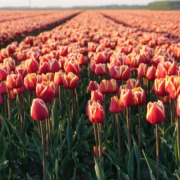Bohemian and Saxon Switzerland are two national parks that stretch along the border between the Czech Republic and Germany. It’s like a fairy tale: steep cliffs, centuries-old forests, castles perched on crags.
If you don’t want to bother with transport and route planning, there’s a simple option – one-day tours from Prague or Dresden. The bus will take you straight to the start of the trails, so all you have to do is walk and take in the views.
The Czech and German sides each have their own charms – in this article, we’ll explore what’s worth seeing in both.
How to get there
The Czech part of the nature park is located in the Ústí nad Labem Region, in the northwest of the country. There are trains and tourist buses from Prague. The journey by car takes less than two hours.
The German part lies 40 kilometres from Dresden. The fastest and most convenient way to get there is by double-decker trains. Choose a seat on the lower level and enjoy the scenery. To get from the railway stations to the towns of Bad Schandau, Stadt Wehlen and Rathen, where the main trails begin, you’ll need to take ferries across the Elbe.
Tips for tourists
- A day trip to this mountain and forest kingdom isn’t quite enough. It’s better to plan for 2–3 days, or even a full week
- The trails are marked, signposts are everywhere – it’s hard to get lost, but wandering off the designated paths is not allowed
- Make sure you bring trekking shoes and comfortable clothes. Pack waterproofs and drinking water
- Parking is usually paid, and sometimes only accepts cash. The Elbe ferry, ascent to Königstein Fortress, and boat rides in the gorges also cost extra
There are hotels and camping sites in the parks. In summer, it gets crowded, so booking accommodation in advance is recommended.
- The best places to stay on the Czech side are Hřensko, Mezni Louka and Rumburk
- On the German side – the resorts of Rathen and Bad Schandau
Interesting places in Bohemian Switzerland
Many journeys in the Czech Republic begin in the small village of Hřensko. Once home to loggers and carpenters, it has preserved its traditional wooden houses and a 200-year-old church. The park’s key sights lie 5–10 kilometres from each other. The terrain is hilly, so a car or bicycle is more convenient for getting around.
- Pravčická Gate is the largest natural rock arch in Europe, known locally as Prebischtor. As tall as a seven-storey building, this stone arch is a national monument of the Czech Republic. The fairy tale writer Hans Christian Andersen admired it, and it was featured in The Chronicles of Narnia: The Lion, the Witch and the Wardrobe. Nearby stands the elegant castle-restaurant Falcon’s Nest
- Mary’s Rock is a spectacular panoramic viewpoint with a gazebo on the eastern side of the park. The ascent takes 40–45 minutes, and at the top, visitors follow safe steps carved into the stone. The views over the forested valleys are impressive. The most beautiful photos are taken at sunset
- Fairy Cave is a curious cave adorned with ice stalactites and stalagmites in winter. You can reach it via a trail from Krásná Lípa
- The Pink Mountain is a high basalt hill offering sweeping views of the gorges and flat-topped peaks known as table mountains
- Schaunstein Castle consists of ruins of ancient fortifications atop a steep cliff. The location once protected trade routes for centuries. A steep staircase carved into a rock crevice leads to the summit
- Edmund’s Gorge is a narrow passage in the Kamenice River valley. The cliffs here reach up to 150 metres high
What is interesting about Saxon Switzerland
On the German side, sandstone cliffs and mixed forests stretch from the Czech border into Saxony. Hikers, cyclists, horseback riders and rock climbers will all find trails and routes to explore. Paddle boats and pleasure boats cruise the Elbe. Cycle buses and retro Kirnitzschtal trams traverse the park. These vintage carriages, built during the GDR era, are still in reliable use.
- The Bastei Bridge is the landmark of Saxon Switzerland. This arched bridge spans a deep gorge on the right bank of the Elbe, seemingly floating between 190-metre-high cliffs. It’s easy to photograph this marvel – the bridge has a viewing platform offering superb vistas. Nearby, the Malerweg («painters» path) winds across the cliffs. The scenery here is so beautiful that artists and photographers are drawn to it time and again
- Königstein Fortress is a majestic citadel on a 240-metre-high cliff above the Elbe. Once a defensive stronghold, monastery and prison, today it houses a museum and a restaurant. Old artillery guns still stand on the ramparts. From the walls, you can clearly see the stone castles scattered through the valley below
- Bad Schandau is a charming resort in the heart of Saxon Switzerland. Visitors can soak in thermal baths with Elbe views, wander through the botanical garden, ride the historic lift to a viewpoint, and visit a lynx enclosure
- The Marie-Louise mine tunnels offer a route through old mining shafts deep inside the mountain. The tour explains how iron ore was extracted and the hardships of mining life. Nature lovers will enjoy the picturesque underground lake beneath the stone arches
- Langenhennersdorf Waterfall is the tallest waterfall in Saxon Switzerland, where clear water tumbles noisily over several ledges from a height of 9 metres
- The Kuhstall Rock Gate is a striking natural arch the size of a 3–4-storey house. The observation platform stands atop a 300-metre-high cliff and offers a wonderful mountain panorama. A steep climb, known as the «stairway to heaven», leads up to it
- The Lochmühle Mill is a historical building over 450 years old that once milled flour and served as a hotel. A beautiful waterfall can be found nearby
What to try while travelling
The Elbe Sandstone Mountains divide the two countries, but their culinary traditions are very much alike.
- Restaurants serve both hearty Czech fare and solid German classics. You’ll find tripe soup, potato pancakes, roast beef in wine marinade (Sauerbraten), and fresh river fish – usually carp or trout
- Beer is a regional pride on both sides of the border, each country perfecting its own brews over centuries. And they know how to surprise you: in some places, you can even take a hot bath in beer
- For dessert, try Pulsnitz gingerbread, Saxon curd cakes, and the airy, cloudlike Eierschecke cake
If you hike to the Pravčická Gate, make sure to visit the Sokolí hnízdo (Falcon’s Nest) restaurant. Built in the 19th century at the cliff’s base, it has hardly changed. Behind its carved wooden shutters, you’ll find simple but delicious Czech dishes, homemade desserts, and excellent coffee. Most importantly, the view from the terrace is something rare – like sitting inside an old postcard.
» READ MORE – Czech specialities: what to try so you won’t regret your trip
What souvenirs to bring back from your trip
Buying souvenirs in these regions is a joy. Memorable gifts from Bohemian and Saxon Switzerland include:
- On both sides of the border, you’ll find elegant candlesticks, figurines and tableware made from Elbe sandstone – the same stone as the cliffs. Warm, porous and slightly rough, it feels good in the hand
- From the Bohemian side, take home Dečín rowan brandy and herbal liqueurs – with aromas reminiscent of meadows and old apothecaries. Sweet lovers should look for local chocolate and Pulsnitz gingerbread – seasoned with cinnamon, honey and sometimes a touch of pepper
- In local markets and small shops, you’ll find wax candles and figurines, jars of mountain honey, and charmingly rough wooden animals – foxes, owls, raccoons. Imperfectly crafted, but full of character
A wonderful way to take a piece of Czech Republic and Germany with you – without falling back on airport kitsch.






 Jonathan Ybema / Unsplash
Jonathan Ybema / Unsplash 
 lili liu / Unsplash
lili liu / Unsplash  Shinnosuke Ando / unsplash.com
Shinnosuke Ando / unsplash.com  Pixabay
Pixabay sour moha / Unsplash
sour moha / Unsplash
Leave a Reply
Want to join the discussion?Feel free to contribute!